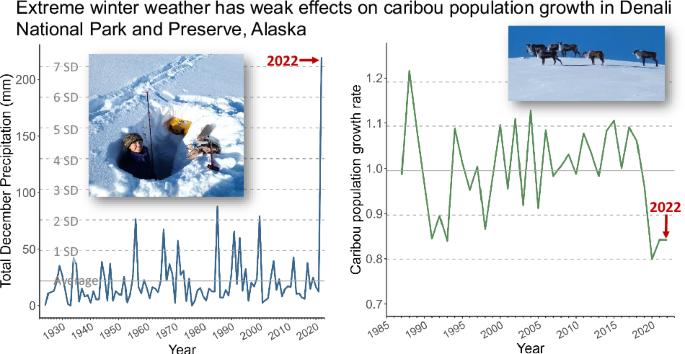Landscape heterogeneity buffers the impact of an extreme weather event on wildlife
IF 5.2
1区 生物学
Q1 BIOLOGY
引用次数: 0
Abstract
Extreme weather events are becoming more frequent, with poorly known consequences for wildlife. In December 2021, an atmospheric river brought record-shattering amounts of rain and snow to interior Alaska, creating conditions expected to cause mass mortality in grazing ungulate populations that need to access ground forage. We characterized snowpack conditions following the storm and used a 36-year monitoring dataset to quantify impacts on caribou (Rangifer tarandus) and their primary predator, wolves (Canis lupus). December precipitation was 7.3 SD above the 99-year mean and 2.5-fold higher than the prior record, with a return period of 333 years. However, ice thickness within the snowpack was highly variable across vegetation types, and caribou shifted to use higher elevations that can blow free of snow. Caribou and wolf mortality rates were 1.3–1.8 SD above normal and caribou population growth rates were low but similar to recent years, indicating a surprisingly weak demographic response. These findings indicate that landscape diversity may bolster resistance of wildlife populations to short-term, potentially devastating effects of extreme weather. Using weather data combined with multi-decadal caribou and wolf demographic data, heterogeneous habitat and topography are shown to mitigate the impact of an extreme precipitation event on wildlife populations in Alaska.

景观异质性可缓冲极端天气事件对野生动物的影响
极端天气事件越来越频繁,对野生动物造成的后果却鲜为人知。2021 年 12 月,一条大气河流给阿拉斯加内陆地区带来了创纪录的雨雪量,预计将导致需要获取地面饲料的放牧麋鹿大量死亡。我们描述了暴风雪后的积雪状况,并利用 36 年的监测数据集量化了对驯鹿(Rangifer tarandus)及其主要捕食者狼(Canis lupus)的影响。12 月份的降水量比 99 年的平均值高出 7.3 SD,比之前的记录高出 2.5 倍,重现期为 333 年。然而,不同植被类型的积雪冰层厚度变化很大,驯鹿转移到可以吹到无雪的高海拔地区。驯鹿和狼的死亡率比正常值高出 1.3-1.8 SD,驯鹿种群增长率较低,但与近几年相似,这表明种群反应出奇地微弱。这些研究结果表明,地貌多样性可能会增强野生动物种群对极端天气的短期、潜在破坏性影响的抵抗力。利用气象数据与十年以上的驯鹿和狼人口统计数据相结合,表明异质性的栖息地和地形可减轻极端降水事件对阿拉斯加野生动物种群的影响。
本文章由计算机程序翻译,如有差异,请以英文原文为准。
求助全文
约1分钟内获得全文
求助全文
来源期刊

Communications Biology
Medicine-Medicine (miscellaneous)
CiteScore
8.60
自引率
1.70%
发文量
1233
审稿时长
13 weeks
期刊介绍:
Communications Biology is an open access journal from Nature Research publishing high-quality research, reviews and commentary in all areas of the biological sciences. Research papers published by the journal represent significant advances bringing new biological insight to a specialized area of research.
 求助内容:
求助内容: 应助结果提醒方式:
应助结果提醒方式:


